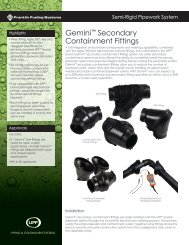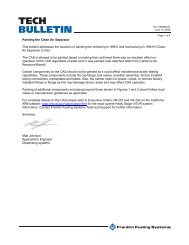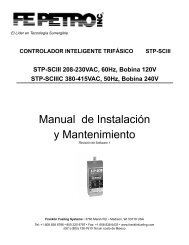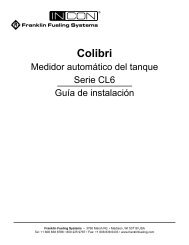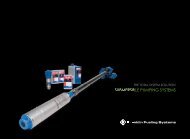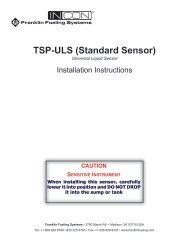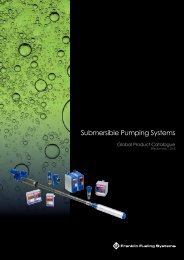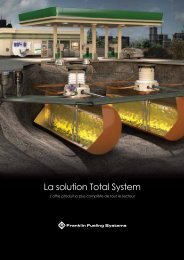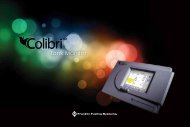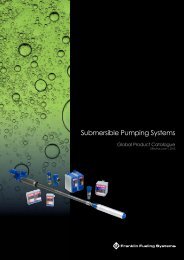Installation: 6280 - Franklin Fueling Systems
Installation: 6280 - Franklin Fueling Systems
Installation: 6280 - Franklin Fueling Systems
You also want an ePaper? Increase the reach of your titles
YUMPU automatically turns print PDFs into web optimized ePapers that Google loves.
<strong>6280</strong>A System Monitor Assembly<strong>Installation</strong> & Service Manual<strong>Franklin</strong> <strong>Fueling</strong> <strong>Systems</strong> • 3760 Marsh Rd. • Madison, WI 53718 USATel: +1 608 838 8786 • 800 225 9787 • Fax: +1 608 838 6433 • www.franklinfueling.com
Printing ReportsEach day at midnight an automatic printout of the previousdays’ activity will be printed. This will show all the previousdata about run time and will show if any errors occurredthat day. It does not show a history of errors.To get a history printout, press both RESET buttons on thefront panel at the same time to print a 15-line summary ofthe last 15 failures. If there are more than 15, the oldestline is dropped off and the latest line is added.Pressing the PRINT button will get an up-to-the-minuteprintout of the site summary and current activity. Allprintouts should be saved for local authorities.The <strong>6280</strong> has a replaceable printer ribbon cartridge anduses standard non-thermal paper. The replacement partnumbers for the paper and the ribbon are:<strong>6280</strong>28 Printer paper roll<strong>6280</strong>29 Printer ribbon cartridgeRefer to the section “Changing Paper / Ribbon CartridgeGuide”.System Monitor Control Box (SMCB)The SMBC serves as a junction box for the CB1relay / CB1A relay socket and the 1005W-4 solid-staterelay. It also acts as a junction box for the wiring cablesupplied from the <strong>6280</strong> System Monitor, the 12VDC pluginpower supply, field wiring from the 9800-1 PressureSwitch, field wiring from the 6275 Vent Sensor Assembly,and field wiring from the gasoline pump motor relays.Mounting the SMBCMount the SMCB near the gasoline pump motor relays andnear a 110V standard electrical outlet for the 12VDC pluginpower supply.It should also be near the electrical conduits from the9800-1 Pressure Switch and the 6275 Vent SensorAssembly. Mount the box firmly using screws (notsupplied) through the holes in the bottom of the box.The CB1 Relay, mounted in the CB1A relay socket, isconnected to the power of the vacuum source and closesa contact that activates the yellow MOTOR LED light andusually the red LOW LED, on the <strong>6280</strong> System Monitor.The RUN light will illuminate and the LOW light goes darkwhen the monitor receives the signal from the 9800-1Pressure Switch, that the proper vacuum level has beenreached within the predetermined time.With an input signal from a gasoline pump motor relay, the1005W-4 Solid State Relay senses the activation of anyproduct pump and transfers that signal to the starting relayof whichever vacuum source is being utilized at the site.Note: Keep high-voltage wiring and low-voltage wiring inseparated conduit.Wires from 12VDC Supply10192112191120109Wires to <strong>6280</strong> SystemMonitor Box212012211121Wires to Switches3 57BrownOrangeYellowRelay Inputs405277901CB1 Relay withCB1A Relay Socket1005W-4 Relay1Black110 Volt Supply2White1789220BlueSMCBOutput to Relay withVacuum SourceFigure 2: SMCB Wiring5
SMCB Wiring InstructionsThese instructions cover the Healy <strong>Systems</strong> SMCB usedwith the Model <strong>6280</strong> System Monitor. Follow all cautionnotices and make sure all power is turned off while makingconnections. Make sure all power is on the same phase,including that of the gasoline pump motor relays.Note: All Class 2 wiring is being run as Class 1 and canbe run together per the Article 725 of the NEC. Theuse of shielded, twisted pair wire (18AWG min.) isrecommended for remote sensor wiring.The SMCB has some connections already made and fieldwiring pigtails already installed. Make sure the wiring iscontained within the appropriate twist retainers. MixingClass 1 and 2 voltages is acceptable within the SMCBonly, provided the Class 2 is wired with Class 1 wire and¼" spacing is maintained.Wire numbers refer to wiring schematics on page 7 & 8– refer to it and the instructions below frequently to assureproper dressing. Multiple conduit openings are available.The seven wires which run to the <strong>6280</strong> system monitor,in the front of the store / station, should be numbered inthe field to correspond to the drawing as well. Field wiringmust be run in conduit to correspond to NFPA 70 and 30Aand be of NEC types for Class 1, with a minimum #18AWG, with 600 volt insulation.Install a 110 VAC non-switched outlet near the SMCB, forpower to the plug-in 12 VDC power supply. The two wire(zip cord) output of this unit supplies the SMCB and isepoxied to the strain relief bushing supplied. There is a redLED epoxied into the strain relief which indicates when the12VDC is present.The Class 1 wires are identified as red #19 for the +12VDC and black wire #10 for the negative – do not mix thewire numbers during installation. All connections shouldbe made using appropriately sized wire nuts. The powersupply is internally fused and cannot be repaired if theleads are shorted together.The wiring should be separated and contained within thetwist retainers.WireNumberFROMDress thrutwist tie1 110VAC main RED 1005W-4 black lead (1) AC hot to solid state relayTO2 AC neutral RED 1005W-4 white lead (2)CB1 coil (WIRE #2)3 1005W-4 brownlead5 1005W-4 orangelead7 1005W-4 yellowleadRED 110V hot side of submersibleturbine pump relayRED Same as above #3 for secondsource motorRED Same as above #3 for third sourcemotorNeutral returnFUNCTIONInput signal of pump motor control relay which turns on arelay where vacuum source is located (blue wire #17)Same as above. (cap if not used)Same as above,(#3) (cap if not used)8 M3-T2 vac. motor RED Hot side of CB1 control relay coil Provides signal to turn on RUN light.9 CB1-5 White Pigtail WHT CB1-5 white pigtail Provides signal to system monitor box to activateMOTOR light and internal timers10 -12VDC powerWHT Black wire from system monitor Supplies –12VDC to operate systemsupply11 Blue wire from <strong>6280</strong>MonitorWHT 6275 Vent switch, commonterminalProvides the signal to activate system monitor12 Brown wire from<strong>6280</strong> Monitor17 Blue wire from1005W-4 relayWHTRED9800-1 Vacuum switch, commonterminalOutput side of 1005W-4 relay toactivate vacuum sourceProvides vacuum switch signal source to systemmonitorProvides output signal voltage to turn on relay forvacuum source - may be either M3 or M4 as shown ondwgs. 9200-6308-220, Sheets 1 and 218 M4-T2 vac. motorRED Hot side of CB1 control relay coil Provides signal to turn on RUN lightrun control relay19 +12 VDC WHT Red wire from system monitor Supplies +12 VDC operate system20 Green wire from<strong>6280</strong> monitor.21 CB1-3 OrangePigtail––WHTGround lug in center of boxOrange wire from system monitor,signal common, connects to 9800-1 pressure switch, 6275 vent,switch, and terminal #3 on CB1relayCommon ground lug for monitor box (wire #20) allbondsCommon signal return to system monitor6
HEALYSYSTEMMONITOR<strong>6280</strong>12VDC, 1.5APLUG-INPOWER SUPPLY12HEALY 9800-1 PRESSSWITCH MOUNTED W/VAC SOURCE120 VACDISPENSER SWITCH131157L1L2L1L2L1L23517COILT1T2T1T2T1T28M1GAS PUMPMOTOR RELAYM2GAS PUMPMOTOR RELAYM3GAS PUMP MOTORRELAY W/9000 MINI-JETNEUTRAL22220<strong>6280</strong>A Wiring Schematic Number 1CAUTIONALL 120VAC WIRING MUST BE ON THE SAME PHASE.NOTES:1. <strong>Installation</strong> must be in accordance with NFPA70 and NFPA30A.2. Locate the <strong>6280</strong> monitor in position for convenient viewing andhearing of audible alarm by site personnel.3. Electrician must allow sufficient wire to pull thru J-Box to wiredifferential pressure switch.4. Wires 9 thru 15, 19, and 21 are class 2. Low voltage, DC1234567WHTBLUBLKGRNBRNREDORANGEJBOX91110201219219858CB1RELAY37VACUUM ONSIGNAL RELAYCB-1217 YEL5 ORG3 BRNGRAY1BLK1005W-4 SOLIDSTATE RELAY2WHTBLU1720HEALY<strong>6280</strong>21SMCBNON-HAZARDOUS AREAHAZARDOUS AREACOMNCNO21SEE NOTE 3 SEE NOTE 311COMNCNO21HEALY 6275 VENT SENSOR ASSEMBLYMOUNTED ON 2” VENT PIPE7
120 VACDISPENSER SWITCH13L1L23T1T2M1GAS PUMPMOTOR RELAY15L1L25T1T2M2GAS PUMPMOTOR RELAY1SEE NOTE 5NEW GASPUMP MOTORRELAY7L1L2L1L2717T1T2M3GAS PUMPMOTOR RELAY18M4HEALYSYSTEMMONITOR<strong>6280</strong>1234567WHTBLUBLKGRNBRNREDORANGEJBOX9111020121921918CB1RELAY5837VACUUM ONSIGNAL RELAYCB-12112VDC, 1.5AHEALYPLUG-IN<strong>6280</strong>21POWER SUPPLYHEALY 9800-1 PRESSSWITCH MOUNTED W/VAC SOURCE12NCCOMNO21SEE NOTE 3 SEE NOTE 311COMNCNONEUTRAL2220<strong>6280</strong>A Wiring Schematic Number 2CAUTIONALL 120VAC WIRING MUST BE ON THE SAME PHASENOTES:1. <strong>Installation</strong> must be in accordance with NFPA70 and NFPA30A.2. Locate the <strong>6280</strong> monitor in position for convenient viewing andhearing of audible alarm by site personnel.3. Electrician must allow sufficient wire to pull thru J-Box to wiredifferential pressure switch.4. Wires 9 thru 15, 19, and 21 are class 2. Low voltage, DC5. UL listed motor control relay for HP of vacuum source,size 1 or smaller.2Dedicated STP for Healy 9000 Mini-Jet (or) VP500 vane pump ½ HP50/60HZ 115/230VAC7 YEL5 ORG3 BRNGRAY1BLK1005W-4 SOLIDSTATE RELAY2WHTBLU1720SMCBNON-HAZARDOUS AREAHAZARDOUS AREA21HEALY 6275 VENT SENSOR ASSEMBLYMOUNTED ON 2” VENT PIPE8
6275 Vent Sensor AssemblyFigure 3: 6275 Vent Sensor AssemblyThe 6275 Vent Sensor assembly is mounted on top of themanifolded tank vent pipes below the +1.5” WC PressureVent Valve (P/N HPV1.5).Two wires (16 or 18 AWG) from the SMCB exit the buildingthrough a sealed conduit. These wires must be 600volt rated, Class 1 type insulation. They connect to theswitch terminals common (COM) and normally open (NO)inside the 6275 Vent Sensor Switch. See <strong>6280</strong>A WiringSchematics 1 and 2 (Pages 7 & 8) for general layoutand installation requirements. These wiring diagrams arepart of the Healy <strong>Systems</strong> Model <strong>6280</strong> System Monitor<strong>Installation</strong> Instructions.<strong>Installation</strong> of the 6275 Vent Sensor AssemblyThe Healy System 6275 Vent Sensor Assembly consistsof the vent sensor body assembly plus the Model 6275Pressure Switch. In addition, a +1.5" WC pressure ventvalve is mounted on top of the sensor, with the designationHPV1.5. This unit is intended for use only with the <strong>6280</strong>System Monitor and must be installed in parallel with the+3" / -8" WC CARB-approved pressure / vacuum vent valveP / N HPV V. Refer to Figures 5 & 6.All wiring must be done in accordance with NFPA 70 and30A requirements. Conduits must be properly sealed forhazardous locations, both in the vent area and inside thebuilding where the wires terminate, per NEC.If the installation is being done as a retrofit:1. Remove the existing P / V valve and replace it witha tee and short nipple, straight up.2. Place the Vent Sensor Assembly on top of thisnipple, and connect the wiring as shown on 6380AWiring Schematics (Pages 7&8), blue wire tocommon (C) and orange wire to normally open (NO).3. Again using a short nipple, attach the HPV1.5Healy Pressure Valve to the top of the Vent SensorAssembly, being sure to use a UL-classified,non-hardening pipe joint compound. Use careand fasten wrench only on the lower part of theHPV1.5. Turning a wrench on the upper half of theHPV1.5 will cause damage.4. Use two eight-inch nipples and an elbow to makea parallel stand to accept a CARB-approved+3" / -8" WC pressure / vacuum vent valve.The 6275 is factory calibrated for flow rate activation.If testing / calibration is required, note that, due to thevery low pressure involved, the response of the pressureswitch is not immediate. When making adjustments, do soin small increments and wait about one minute betweenadjustments of the screw.9
Vent Sensor AssemblyPressure SwitchItem # 62755U LVENDOR I.DLow SideHigh SideFigure 4: 6275 Vent Sensor Assembly10
+1.5" WC PressureVent Valve Assy.PN: HPV 1.5+3" / -8" WCPressure / Vacuum VentValve Assy. PN: HPV VVent Sensor Assy.PN: 6275All piping 2". Use areducing adapter toconnect to larger pipeFigure 5: Vent Piping Detail+1.5" WC PressureVent Valve Assy.PN: HPV 1.5+3" / -8" WCPressure / Vacuum Vent ValveAssy. PN: HPV VVent Sensor Assy.PN: 6275Figure 6: Alternate Vent Piping Detail<strong>Installation</strong> shall be done in accordance with California Air Resources Board regulation, sub-chapter 11.5, and local regulations.Install piping and fittings in accordance with manufacturer’s specifications.11
9800-1 Pressure SwitchThe Healy Model 9800-1 Switch is UL Listed for use inClass 1, Group D Locations in conjunction with a HealySystem Monitor. The switch is factory set at approximately65" WC and should not need adjustment in the field. Referto the previous Vent Sensor section for more detailedinformation.MountingThe 9800-1 Vacuum Switch is mounted on the Stage IIVapor Return line from the dispensers, usually in a pit orsump at underground systems outside the building. Forabove-ground installations, the switch is mounted near thevacuum source. Two wires (16 or 18 AWG) from the SMCBexit the building through a sealed conduit (per NEC).*Shielded twisted pair wiring is strongly recommended.Vacuum Line <strong>Installation</strong>There are two 1/8”NPT ports on the base of the switch,one marked “A” and the other “B.” A piece of ¼” coppertubing is run from the vapor return line (vacuum) to the“A” port. This tubing must be pitched from the “A” port ofthe switch to the vacuum line allowing gravity drainage ofvapor condensation. Do not allow any traps to occur whichwould block the tube if condensation occurs.Port “B” has a breather filter vent installed. DO NOTREMOVE. (See Figure 7)Electrical <strong>Installation</strong>• The switch should be mounted with the electrical conduitfitting pointed downward.• All wiring must conform to Class 1, Group D,requirements of the NEC, including sealing the conduitwithin 18 inches of the connections.• The wiring must be 18 AWG, 600 V, rated for the service(shielded, twisted pair is strongly recommended).• The wiring connections are done on a terminal boardlocated under the cover with the label. The wires areconnected to the two terminals with slotted screw heads.Between these two screws is a raised Phillips-headscrew – this is an adjustment screw, not a terminal. Donot turn this screw.Two wires coming from the <strong>6280</strong> System Monitor getconnected; one to each terminal, without regard to whichwire goes on what terminal.At the <strong>6280</strong> System Monitor control box, one wire isconnected to the orange wire (#21) and the other isconnected to the brown wire (#12) going to the monitor.See Healy <strong>Systems</strong> wiring diagram 9200-6308 sheets1 and 2 for general layout and installation requirementscontained with Healy Model <strong>6280</strong> System Monitor.12
9800-1 Test ProcedureCAUTION: Use extreme care when verifying the switchingaction.Use a digital multi-meter set to DC Volts in the 25-voltDC range. With the Healy Model <strong>6280</strong> System Monitorconnected and operational, a voltage between 3 and 15VDC should be present without vacuum.Use an explosimeter to assure the area around the switchis safe. Do not attempt to verify switch using a light bulbtester. This will blow out the switch element. Connect thedigital multi-meter, one lead to each switch terminal onthe 9800-1.Install a 0-100" WC gauge to test port located near thevacuum source. Make sure that there is no dispensingduring testing and that vacuum level is 0” inches watercolumn. Activate vacuum source by authorizing any nozzle.Observe the vacuum gauge while the vacuum is increasingand note at what vacuum level the multi-meter shows “0”that indicates the switch connection. Adjust the switchactivation point by turning the phillips head screw locatedbetween the electrical connections for the model 9800-1.Clockwise will cause earlier making of the contact, counterclockwise will cause later making of the contact. Adjust sothat the switch makes contact at 65" WC as the vacuum isbuilding.Note: There is a small dead-band in the switch, whichprevents the switch from making contact at thesame number on a decreasing vacuum. Be sureadjustments are always made on an increasingvacuum and that the vacuum is allowed to decaybefore rechecking the switch point.If a failed switch is suspected, use long lengths of jumperwires to move the connection point to a safe area andshort the two terminals together. If the LOW light goes outon the monitor, then the switch is defective and will need tobe replaced. This must be done as a complete unit as theswitch element itself cannot be replaced in the field.“B” PortHEALYSYSTEMS MODEL9800-1 PRESSURE SWITCHLISTED 55GL FOR USEIN CLASS 1, GROUP D LOCATIONSContacts rated .01 A, 30 VDC Industrial control equipmentFor use in hazardous locations. Temperature range -25 to + 80°CWARNING: To reducethe risk of ignition ofhazardous atmospheres,disconnect this devicefrom the supply circuitbefore opening cover.Keep switch tightlyclosed when operating.Conduits must be sealedwithin18" of enclosure.CAUTION: To verify switchactivation, remove switchto a safe area and use aDIGITAL ohmmeter. Donot attempt to use lightbulb type tester.Use only with HEALYSystem Monitor.INSTALLATION INSTRUCTIONS: Install switch vertically, withelectrical bushing pointing downward. Conduit must be sealedper NEC requirements for explosive environments. Do notover tighten terminals or cover. Do not turn the centerscrew between electrical terminals unlesscalibrating switch.Lbl p/n 9807VEND. ID“A” PortBreather FilterFigure 7: 9800-1 Pressure Switch13
System ProgramThe Healy Model <strong>6280</strong> System Monitor is supplied withtwo 3.5” floppy disks to load in a laptop / personal computer(not Healy supplied) using a 9 pin straight through pin-topinRS232 cable (not Healy supplied).Figure 8: <strong>6280</strong> RS232 ConnectionThis program allows the installer to:• Change the COM port parameters• Customize the printout with the site name• Change printout parameters• Select the hourly print option (See instruction sheetprovided with disks).If your computer lacks a disk drive, contact FFS TechnicalService at 1-800-984-6266 for the required files.The <strong>6280</strong> System Monitor automatically takes the time anddate from the laptop / personal computers internal settings.Note Make sure the internal time and date are correctbefore software installation.The program runs under the Windows operating system.Follow directions on the disk label for loading instructions.Note: The system does not require that the program beinstalled in order to perform properly. The resultsof not programming are a blank site name and thetime recorded as Eastern Standard or DaylightTime. The date will be correct. The disk contains nooperational features set-up.The disk also contains a HELP file that explains the theoryof operations of the System Monitor.Downloading ParametersSome of the Model <strong>6280</strong> Healy System Monitorparameters can be customized for individual applications.Since parameters can be configured for each user, aprogram was created to support this need.Note: This is a Windows program that allows the userto send parameters from your computer to theHealy System Monitor via the RS232 ports using astraight through pin-to-pin RS232 cable (not Healysupplied).The Laptop or Personal Computers internal settings forproper communications are as follows:• BAUD RATE = 9600• DATABITS = 8• PARITY = NONE• STOPBITS = 1• FLOW CONTROL = XON / XOFFBelow is a description of the download parameters andwhat effect they have on the <strong>6280</strong> System Monitor.General ParametersSerial Port This is the RS232 port on the PC that willbe used to send the parameters to the <strong>6280</strong>System Monitor.The following are valid selections: COM1,COM2, COM3 or COM4.The RS232 connector is usually a 9 or 25 pinmale connector found in the back of the PC.CompanyNameCurrent DateCurrent TimePrintoutParametersHourly PrintPut the name of the Healy System user in thisfield. Only 40 characters are allowed. Whena print out is made from the <strong>6280</strong> SystemMonitor the service station name will bedisplayed at the top of the printout.The date field cannot be changed. This valueis read from the computer clock and is passeddown to the <strong>6280</strong> System Monitor controlboard so the control board has the currentdate.The time field cannot be changed. This valueis read from the computer clock and is passeddown to the <strong>6280</strong> System Monitor controlboard so the control board has the currentdate.This control turns printing “ON” or “OFF” forthe parameters described in this section. If youdo a printout from the <strong>6280</strong> System Monitorand the Printout Parameters control was setto “ON”, then all these parameters are printedout. After installation and verification thatthe system is operating within specification,leaving this switched to “OFF” will save paper.This parameter is set to “ON” for systemproblem diagnosis. It will provide informationregarding hour-by-hour changes. It shouldbe set to the “OFF” condition for normalmonitoring.(Continued on next page)14Figure 9: Healy <strong>6280</strong> Setup Screen
Vacuum ParametersMax. Startup Time(Sec)Max. Vac Err.Before AlarmVent ParametersVent Test PeriodMax. Vent PeriodThe time allowed for the vacuum toreach a normal level. This value cannotexceed the Maximum Errors BeforeAlarm number. If it does an audible alarmsounds. For example, if the MaximumStart-Up Time equals 15 seconds andthe Maximum Errors Before Alarm equals3, and if the vacuum does not reacha normal level on three consecutivevacuum pump start / stop cycles, theaudible alarm sounds.Factory set to 15 seconds.This is how many times the MaximumStart-Up Time can be exceeded beforesounding an alarm.Factory set to 3.This is the time period that venting ismonitored. If the Maximum Vent periodvalue is exceeded during this time period,the audible alarm sounds.Factory set to 24 hours.This is the total maximum venting timeperiod that cannot be exceeded duringthe Vent Test Period. For example, if theVent Test Period is set to 24 hours andthe Maximum Vent Period is set to 10hours, then during a 24-hour period thesystem is not allowed to vent for morethan an accumulated 10 hours. If it does,the audible alarm sounds.Factory set to 10 hours.Button DescriptionsDownloadThe RS232 cable must be connectedfrom the Healy <strong>6280</strong> System Monitor tothe PC. When the “DOWNLOAD” buttonis clicked all the parameters described inthis section are transferred to the HealySystem Monitor system via the RS232cable. This is so the parameters can becustomized for each customer.Clear Data This will bring up a new screen requiringpassword access to clear all systemhistory and timers. This function is forfactory use only.CancelThis will cause the “DownloadParameters” dialog box to be releasedand no parameters will be transferred tothe Healy <strong>6280</strong> System Monitor.HelpHelp loads the “Help” file for the Healy<strong>6280</strong> System Monitor.Interpreting the <strong>6280</strong> System Monitor Printout1.2.3.4.5.6.7.8.9.10.11.12.13.14.15.16.17.18.19.20.21.22.23.24.25.26.27.28.Figure 10: Sample <strong>6280</strong> System Monitor Printout15
Refer to the table below for explanations of the printoutshown on the previous page.LineDescription1 Customer inputs, Station Name and Number.2 Date is automatically loaded during softwaredownloading.3 The time is automatically loaded during softwaredownloading.Vacuum Information4 The System Time is the total amount of timethe system has been powered, not just the timedispensing is authorized.5 The sum of the above. It will always equal 100%.6 Is the cumulative amount of time the vacuumsource has been activated.7 Is the numerical display of the above. The % is inrelation to the total system time.8 Run time is the amount of time that the vacuumhas been at 65" WC or greater. The % is ofmotor time, not system time.9 Is the numerical information of the above.Venting Information10 Vent Test Period is the time established by CARBand cannot be changed by the customer.11 Is the numerical display of the above and cannotbe changed by the customer.12 Vent Alarm Period as above, which has beenestablished by CARB to be the test period.13 Is the numerical display of the Vent Alarm period.14 Accumulated Vent Time15. Represents the total time for the 24 hour period16 Total Accumulated Vent time is the total of all thevent time since start-up.17 Is the numerical display of above in days, hoursand minutes.Parameter Information18 Vent Test Period as established by CARB.This 24 hour period cannot be changed by thecustomer.19 Is the maximum vent period as established byCARB and cannot be changed by the customer.This 10 hour period cannot be changed by thecustomer.20 Is the Maximum Vent Error Before Alarm isestablished by CARB at 1 and cannot bechanged by the customer.21 Maximum Run Startup time is set by CARB at 15seconds.22 Maximum number of vacuum errors beforealarm. This has been set by CARB at 3.23 The auto printout time is factory set at 12:01 AM,but may be changed by the customer, using theHealy software and a Windows based PC.24 The hourly printout is factory set at ‘off’, but maybe changed by the customer, as above. Thesystem will automatically printout at 12:01 AM, orwhatever time the customer selects.Failure Information25 Will show the last failure occurrence, if there wasone that day.Failure History ReportThis is a tabulation of the last 15 (maximum) overtoleranceconditions, with the most recent recordedon the bottom. If there are more than 15 items in thememory, the oldest will be replaced. This removal doesnot effect system totals shown above.Examples: Failure History Report26 Vac. Failure at 09:30 on 08/22/98 (123). Thisline indicates that there was a vacuum failure at09:30 hours, was not repaired and was followedby 123 successive occurrences before midnight.27 No Vacuum Failure at 19:45 on 08/28/98. Thisindicates that the vacuum source was startedat 19:45 and for a period of at one hour, therewas no Vac OK signal received. There are nooccurrences with this specification.28 Excess Vent Failure at 17:15 on 08/30/98indicates that there was venting which exceededthe specified number (10 hours). Successivefailures would be individually recorded.16
Changing Paper / Ribbon Cartridge GuideNote Before replacing the paper or ribbon cartridge, readall the instructions and locate the paper feed buttonon the back panel of the <strong>6280</strong> System Monitor.Replacement Part Numbers:<strong>6280</strong>28 Printer Paper Roll<strong>6280</strong>29 Printer Ribbon CartridgeReplacing the Printer Paper Roll1. Remove the front panel by grasping the edges (notthe top) of the black printer cover panel and slidedown (See Figure 11).9. Slightly tip the roll and shaft, so the bottom entersthe paper cavity first and the pin on the end of theshaft can be inserted behind the lower tab. Thenpush the top pin into its place in the forked papersupport. Pin should snap in and hold the paper inplace. Do not try to push both ends in place atthe same time.10. Turn the unit back upright and push the black printbutton to be sure the paper is feeding correctlyand the ribbon is on top of the paper.11. Replace the front panel with the teeth of the papercutter on top. Advance about two inches of paperto slide through the slot before pushing the panelin position.Replacing the Printer Ribbon Cartridge1. Remove the printer panel and tear off any excesspaper.2. Observe the left end of the ribbon cartridge whereit has the word PUSH (See Figure 13). Press hereto eject ribbon.Figure 11: Remove Printer Cover2. Examine the paper cavity to see how items arearranged. Look for the metal bar, just in front of thepaper IN slot.3. Remove any paper still in the paper OUT slot.4. Grasp the pin on the left end of the paper shaftand pull to remove. Discard the empty paper core.5. Turn the monitor unit on its right side.6. Cut the front edge of the new printer paper roll,(part #<strong>6280</strong>28) to a blunt point (See Figure 12).Cuts must be clean and sharp with no raggededges.Figure 12: Prepare Paper7. Slide the paper point into the paper IN slot and pressthe paper feed button on the back of the unit whileguiding the paper in. Paper should advance throughthe paper OUT slot. If the paper has not appearedafter 10 cycles, pull paper back and reinsert.8. Place the paper shaft in the core of the new paperroll, with the cross pin (See Figure 12) on top.Figure 13: Remove Printer Ribbon Cartridge3. Carefully remove the new ribbon cartridge fromthe blister pack and be sure it is straight and tight.If ribbon is loose, tighten by turning the star wheel(clockwise) on the right side of the ribbon until thereis no slack.4. Place the right end over the protruding shaft, andthen snap the left end in place using your thumb.Be sure the ribbon is on top of the paper.5. Push the black print button for a sample print to besure the ribbon is on top of the paper.6. Resume normal operation.17
<strong>6280</strong> MONITOR MAINTENANCE LOG SHEETCalifornia Air Resources Board Compliance DivisionGasoline Vapor recovery Certification ProgramFACILITYSUPERVISOR / CONTACT NAMEADDRESS( )FACILITY PHONE NUMBERCITY STATE ZIP CODE INSTALLATION DATEDate & Timeof AlarmType ofAlarmDate & TimeMaintenanceCalledDateMaintenancePerformedMaintenance Contractor:Phone: ( )Maintenance PerformedA. Test(s) Conducted:__________Date:Vacuum:___________Date:___________Date:__________Time:Vent:___________Time:B. Test Results: (Attach Additional Sheets If Needed)Comments:C. Component(s) Repaired or Replaced:18
FIELD TEST GUIDEHEALY <strong>6280</strong> MONITOR SYSTEMThese tests are to determine if the <strong>6280</strong> System Monitor isdetecting switch closures correctly.Note: This must be done with no fueling positions active atthe time of testing.Identify the wires from the monitor cable as follows: theyall should be numbered and / or colored.• Wire number 9 is white, going to the common of CB1.• Wire number 10 is black, going to –12VDC.• Wire number 11 is blue, going to the common of the6275 Vent Sensor.• Wire number 12 is brown, going to the common ofthe 9800-1 Pressure Switch.• Wire number 19 is red, going to +12VDC.• Wire number 20 is green, going to ground.• Wire number 21 is orange, going to the switch returns.MOTORLOWRUNRESETVENTEXCESSRESETPOWERPRINTFigure 14: Location of the “LED” lights on the control panel.Expose the ends of wires #9, #10* #11, and #12 byremoving the wire nuts one at a time and only as neededleaving the wires connected to their original source whiletesting. Connect one end of a jumper to wire #10* blackwire and follow the guide below for the other end of thejumper wire and the connections needed to test thefollowing:To verify the “LED” lights on the vacuum side of the controlpanel follow the instructions below:1. From wire #10* black, connect the other end of thejumper wire to wire #9. The “MOTOR” light and the“LOW” light should illuminate.2. Tie wire #9 and #12 together, leaving the other endof the jumper wire connected to wire #10*. The“LOW” light should go off. The “MOTOR” light shouldremain on and the “RUN” light should illuminate.These connections imitated the CB1 Relay, (located inthe SMCB box), being activated and the 9800-1 PressureSwitch being activated.To verify the “ALARM” function for the “VACUUM” side ofthe control panel follow the instructions below:Note: The alarm tests must be separated by at least fourhours, as pressing the reset silences the alarm forfour hours and no fault will not cause it to resound.1. Disconnect wire #12 from wire #9, leaving wires #9and #10* connected with the jumper wire and holdfor 15 seconds then reconnect wire #12.2. Repeat this two more times. (An alarm shouldsound)3. Silence the alarm by pressing the reset button onthe “Vacuum” side of the control panel.4. Disconnect the jumper wire and rewire system tooriginal connections.This will simulate three consecutive starts with no vacuumpresent.To verify the “LED” lights on the vent side of the controlpanel follow the instructions below: (SEE NOTE ABOVE)1. From wire #10* connect the other end of thejumper wire to wire #11. The “VENT” light shouldcome on.This connection imitated the 6275 Vent Sensor beingactivated.To verify the “ALARM” function for the “VENT” side of thecontrol panel follow the instructions below:1. Connect wire #10* to wire #11. (Must be leftconnected for 10 hours).Note: To run this test without shutting down a locationfor 10 hours, disconnect wire #11 from the <strong>6280</strong>System Monitor to the 6275 Vent Sensor and capoff the wire from the 6275 Vent Sensor. Use onlythe #11wire from the <strong>6280</strong> System Monitor leavingwire #10* connected to its source in the junctionbox.2. At 10 hours the “EXCESS” light should come onand an alarm will sound.3. Silence the alarm by pressing the reset button onthe “Vent” side of the control panel.4. Disconnect the jumper wire and rewire system tooriginal connections.This will simulate the 6275 Vent Sensor venting in excessof 10 hours.* Or substitute wire #21 orange wire if so equipped19
HEALY <strong>6280</strong> MONITOR TROUBLESHOOTING GUIDEAPPLICATION:The Model <strong>6280</strong> System Monitor can go into three specific alarm conditions, “NO VACUUM” FAILURE, “VACUUM”FAILURE, OR “EXCESS VENT” FAILURE.The failure responsible for the alarm sounding can be determined by reviewing the <strong>6280</strong> System Monitor “Failure History”printout. To generate this printout, simultaneously push both RESET buttons. A history of the last fifteen failures will beprinted, along with the date and times of the failures and the number of failures on that date.The alarm can be silenced for four hours by pressing the RESET button next to the red light flashing under the VENT orVACUUM headings. When the alarm has been silenced, the red lights will continue to flash until the problem is repaired.The alarm will sound again if the cause of the failure is not repaired within four hours.SYMPTOMS: “NO VACUUM” FAILUREThis means the Vacuum source has not achieved a reading of 65" WC or above within one hour of the vacuum sourceactivation. This failure occurs when the vacuum source, (9000 Mini-Jet or VP500 Vane Pump), has been powered for morethan one hour without the System Monitor receiving a signal from the 9800-1 Pressure Switch.Possible CausesSolutions1. Significant leak in the vapor line, this would also causeexcess venting. (9000 Mini-Jet or VP500)1. Test vapor recovery lines for leaks. Repair as needed.(9000 Mini-Jet or VP500)2. Vacuum source failure. (9000 Mini-Jet or VP500) 2. Repair or replace the vacuum source. (9000 Mini-Jetor VP500)3. Improper wiring of the system. (9000 Mini-Jet orVP500)4. Part #9800-1 Pressure Switch out of adjustment ordefective. (9000 Mini-Jet or VP500)5. Vacuum source under sized for the amount of fuelingpositions. (9000 Mini-Jet or VP500)3. See <strong>6280</strong>A Wiring Schematics (page 7&8) for correctwiring. (9000 Mini-Jet or VP500)4. Inspect pressure switch with a digital voltmeter and a 0– 100" WC vacuum gauge for actuation of the pressureswitch. Switch should send a signal to the normallyopen terminal when 65” WC is created. (9000 Mini-Jetor VP500)5. 9000 Mini-Jet will accommodate up to 8 fuelingpositions and the VP500 up to 10 fueling positions.NOTE: Each vacuum source is based on 50%utilization of fueling positions. (9000 Mini-Jet or VP500)6. Tubing not properly installed. (9000 Mini-Jet or VP500) 6. Tubing must drain from the high side of the pressureswitch. (9000 Mini-Jet)7. Vacuum regulation not set between 65" and 85" WC.(9000 Mini-Jet & VP500 only)8. Submersible Pump not supplying adequate fuel to theMini-Jet. (9000 Mini-Jet only)9. Vacuum source not installed properly. (9000 Mini-Jetor VP500)7. Adjust regulator to approximately 80" WC.(9000 Mini-Jet)8. Check submersible pump pressure. Normal operatingpressure for a 1½-HP submersible is between 27 to 33PSI and a minimum of 20 PSI with maximum numberof nozzles flowing. (9000 Mini-Jet)9. 9000 Mini-Jet should be installed in a vertical position.(9000 Mini-Jet)10. Flame arrestors clogged. (VP500 only) 10. Remove flame arrestors, clean and reinstall. (VP500)11. 9000 Mini-Jet strainer is clogged and restricting fuelflow through the pump. This results in vacuum beingcreated slowly by the pump. (9000 Mini-Jet only)11. Clean strainer and verify vacuum source creates 65"WC of vacuum within 15 seconds. (9000 Mini-Jet)20
SYMPTOMS: “VACUUM” FAILUREThis failure occurs when the <strong>6280</strong> System Monitor does not receive a signal from the pressure switch of 65" WC within15 seconds of the start of the vacuum source for three consecutive times.Possible CausesSolutions1. Significant leak in the vapor line. (9000 Mini-Jet orVP500)1. Test vapor recovery lines for leaks. Repair as neededNOTE: Refer to vapor line test procedures. (9000 Mini-Jet or VP500)2. Vacuum source failure. (9000 Mini-Jet or VP500) 2. Repair or replace the vacuum source. (9000 Mini-Jetor VP500)3. Improper wiring of the system. (9000 Mini-Jet orVP500)4. Part #9800-1 Pressure Switch out of adjustment ordefective. (9000 Mini-Jet or VP500)5. Vacuum source under sized for the amount of fuelingpositions. (9000 Mini-Jet or VP500)6. Tubing from the pressure switch not properly installed.(9000 Mini-Jet or VP500)7. 9000 Mini-Jet regulation not set between 75" and 85"WC. (9000 Mini-Jet only)8. Submersible pump not supplying adequate fuel to theMini-Jet. (9000 Mini-Jet only)9. Vacuum source not installed properly. (9000 Mini-Jet orVP500)3. Refer to <strong>6280</strong>A Wiring Schematics (page 7&8) forcorrect wiring. (9000 Mini-Jet or VP500)4. Inspect pressure switch with a digital voltmeter and a0 – 100" WC vacuum gauge for actuation of thepressure switch. Switch should send a signal to thenormally open terminal when 65" WC is createdNOTE: Remove switch to safe area for testing. (9000Mini-Jet or VP500)5. 9000 Mini-Jet will accommodate up to 8 fuelingpositions and the VP500 up to 10 fueling positions.NOTE: Each vacuum source is based on 50%utilization of fueling positions. (9000 Mini-Jet orVP500)6. Tubing must drain from the high side of the pressureswitch. (9000 Mini-Jet or VP500)7. Adjust regulator to approximately 80" WC.(9000 Mini-Jet)8. Check submersible pump pressure. Normal operatingpressure for a 1½-HP submersible is between 27 to 33PSI and a minimum of 20 PSI with maximum nozzlesflowing. (9000 Mini-Jet)9. 9000 Mini-Jet should be installed in a vertical position.(9000 Mini-Jet)10. Flame arrestors clogged. (VP500) 10. Remove flame arrestors, clean and reinstall. (VP500)11. 9000 Mini-Jet strainer is clogged and restricting fuelflow through the pump. This results in vacuum beingcreated slowly by the pump. (9000 Mini-Jet only)12. Stage II piping diameter and length larger thanaverage. (9000 Mini-Jet or VP500)11. Clean strainer and verify vacuum source creates 65"WC of vacuum within 15 seconds. (9000 Mini-Jet)12. Verify installation of Healy Check Valve #9466 per theinstallation drawings to maintain vacuum on theStage II line. (9000 Mini-Jet or VP500)21
SYMPTOMS: “EXCESS VENT” FAILURESThis failure occurs when the vent sensor records more than 10 hours of venting in a 24 hour period.Possible CausesSolutions1 Leak in the Stage II line allows ingestion of air intosystem. This creates vapor growth in the tank andemissions at the vent. (9000 Mini-Jet or VP500)2. Pressure valve above the vent sensor not operatingproperly and allowing emissions.(9000 Mini-Jet or VP500)1. Test vapor recovery lines for leaks. Repair as needed.(9000 Mini-Jet or VP500)2. Replace pressure / vacuum vent valve or the pressurevent valve and re-test. (9000 Mini-Jet or VP500)3. Stage I connected improperly during a fuel delivery. 3. Inform delivery driver or product supplier of theproblem. (Possible Stage I problem)4. Wiring to Intrinsically Safe Module installed incorrectly.(9000 Mini-Jet or VP500)5. Vent Sensor switch signaling emissions when noneexist.6. Tanks are not manifolded properly or there is blockagein the vent lines.4. Refer to <strong>6280</strong>A Wiring Schematics (page 7&8) forcorrect wiring. (9000 Mini-Jet or VP500)5. Tubing to vent sensor bent and a trap could form notallowing switch to sense lower pressure.6. Test vent lines for blockage and proper manifoldconnections.22
©2009 FFS 000-0137 RevC23



